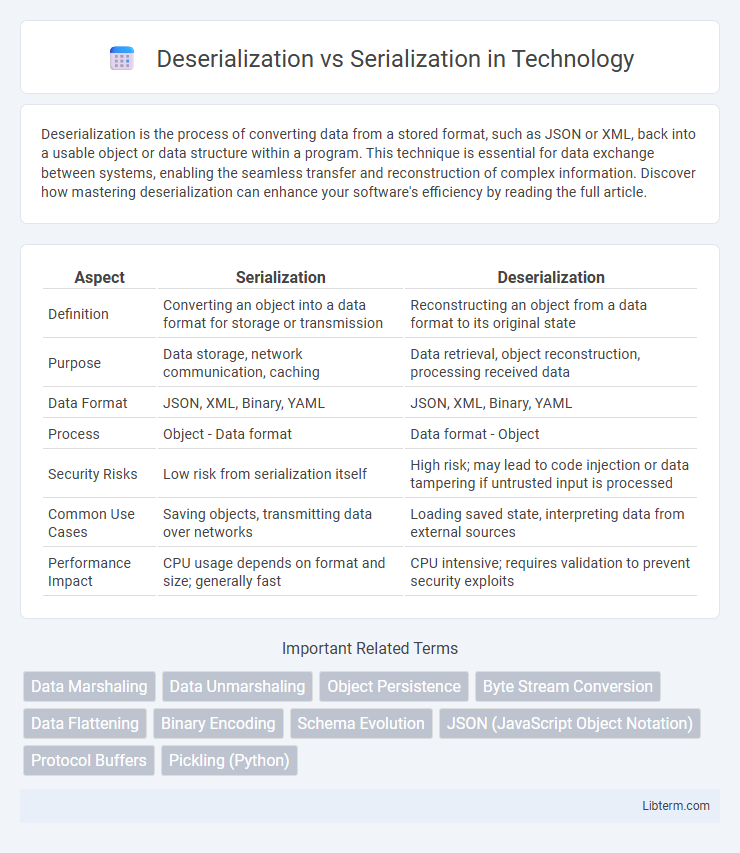Deserialization is the process of converting data from a stored format, such as JSON or XML, back into a usable object or data structure within a program. This technique is essential for data exchange between systems, enabling the seamless transfer and reconstruction of complex information. Discover how mastering deserialization can enhance your software's efficiency by reading the full article.
Table of Comparison
| Aspect | Serialization | Deserialization |
|---|---|---|
| Definition | Converting an object into a data format for storage or transmission | Reconstructing an object from a data format to its original state |
| Purpose | Data storage, network communication, caching | Data retrieval, object reconstruction, processing received data |
| Data Format | JSON, XML, Binary, YAML | JSON, XML, Binary, YAML |
| Process | Object - Data format | Data format - Object |
| Security Risks | Low risk from serialization itself | High risk; may lead to code injection or data tampering if untrusted input is processed |
| Common Use Cases | Saving objects, transmitting data over networks | Loading saved state, interpreting data from external sources |
| Performance Impact | CPU usage depends on format and size; generally fast | CPU intensive; requires validation to prevent security exploits |
Introduction to Serialization and Deserialization
Serialization converts complex data structures or objects into a format suitable for storage or transmission, such as JSON, XML, or binary. Deserialization reverses this process by reconstructing objects or data structures from the serialized format, enabling data retrieval and usage. These processes are essential in data exchange, remote communication, and persistent storage scenarios.
What is Serialization?
Serialization is the process of converting an object or data structure into a format that can be easily stored or transmitted, such as JSON, XML, or binary. This enables data to be saved to files, sent over a network, or stored in databases while preserving the object's state. Efficient serialization is critical in distributed systems, data caching, and remote procedure calls where data interchange between diverse environments is required.
What is Deserialization?
Deserialization is the process of converting data from a serialized format, such as JSON or XML, back into a usable object or data structure in programming. This operation recreates original objects from a byte stream or string representation, enabling applications to reconstruct complex data models for processing or storage. Efficient deserialization is essential for data exchange, remote communication, and persistent storage in software development.
Key Differences Between Serialization and Deserialization
Serialization converts data structures or objects into a format that can be easily stored or transmitted, such as JSON, XML, or binary. Deserialization reverses this process by reconstructing the original object or data structure from the serialized format. Key differences include the direction of data transformation, with serialization enabling data persistence and deserialization enabling data retrieval and usage in applications.
Common Use Cases for Serialization
Serialization is commonly used in data storage and transmission, enabling complex objects to be converted into byte streams for saving to files or databases and sending over networks. It plays a crucial role in remote procedure calls (RPC), allowing objects to be transferred between different JVMs or services in distributed systems. Serialization also facilitates caching mechanisms by storing object states for quick retrieval, improving application performance and scalability.
Common Use Cases for Deserialization
Deserialization is commonly used in data exchange between web services and applications, allowing structured data formats like JSON or XML to be converted back into usable objects. It facilitates the restoration of application state, enabling features such as session persistence, configuration loading, and message queue processing. Deserialization is also essential in APIs where incoming request payloads must be transformed for backend logic execution and database interactions.
Serialization Formats and Protocols
Serialization formats and protocols determine how data structures are converted into a storable or transmittable format and restored back during deserialization. Popular serialization formats include JSON, XML, Protocol Buffers (Protobuf), Apache Avro, and MessagePack, each offering different trade-offs in terms of efficiency, readability, and compatibility. Protocols such as gRPC often leverage serialization formats like Protobuf for efficient and structured communication in distributed systems, emphasizing speed and compact data representation.
Security Risks in Serialization and Deserialization
Serialization and deserialization processes can introduce significant security risks, especially when handling untrusted data, as attackers may exploit vulnerabilities to execute arbitrary code or launch injection attacks. Improperly validated serialized data can lead to deserialization attacks that compromise application integrity and expose sensitive information. Implementing strict input validation, using safe serialization libraries, and avoiding deserialization of untrusted sources are essential practices to mitigate these security threats.
Best Practices for Safe Data Serialization
Safe data serialization requires strict validation of input data formats to prevent injection attacks and data corruption during the deserialization process. Implementing whitelisting techniques restricts the acceptance of only known, safe classes and data structures, minimizing exposure to malicious payloads. Employing secure serialization libraries that provide built-in safeguards and avoiding the use of insecure default serialization methods further enhances data integrity and application security.
Choosing the Right Serialization Approach
Choosing the right serialization approach depends on factors like data format compatibility, performance requirements, and system architecture. Binary serialization offers fast processing and compact size, suitable for high-performance applications, while JSON and XML provide better readability and cross-platform support. Evaluating these criteria ensures efficient data exchange and seamless integration across distributed systems.
Deserialization Infographic

 libterm.com
libterm.com